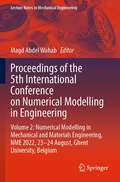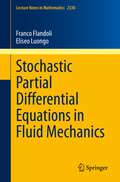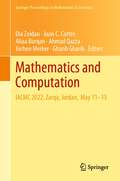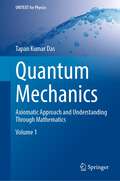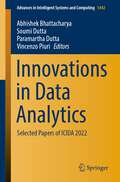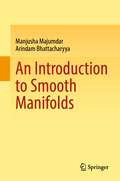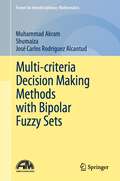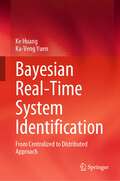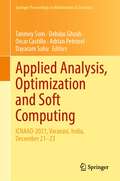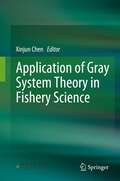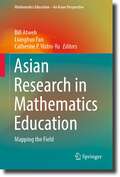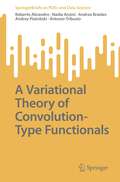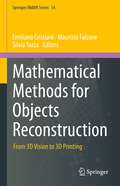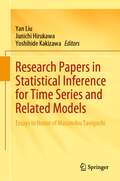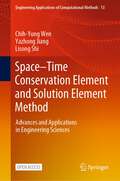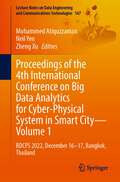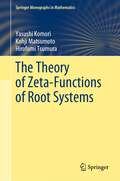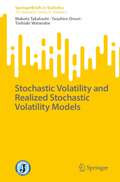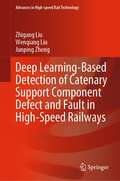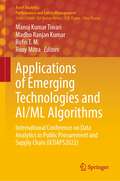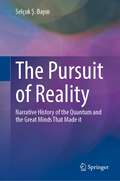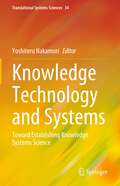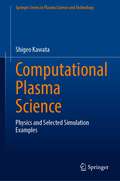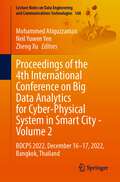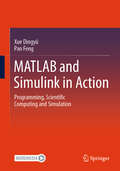- Table View
- List View
Proceedings of the 5th International Conference on Numerical Modelling in Engineering: Volume 2: Numerical Modelling in Mechanical and Materials Engineering, NME 2022, 23–24 August, Ghent University, Belgium (Lecture Notes in Mechanical Engineering)
by Magd Abdel WahabThis book gathers outstanding papers on numerical modeling in Mechanical Engineering (Volume 2) as part of the 2-volume proceedings of the 5th International Conference on Numerical Modeling in Engineering (NME 2021), which was held in Ghent, Belgium, on August 23–24, 2022. The overall objective of the conference was to bring together international scientists and engineers in academia and industry from fields related to advanced numerical techniques, such as the finite element method (FEM), boundary element method (BEM), isogeometric analysis (IGA), and their applications to a wide range of engineering disciplines. This book addresses numerical simulations of various mechanical and materials engineering industrial applications such as aerospace applications, acoustic analysis, bio-mechanical applications, contact problems and wear, heat transfer analysis, vibration and dynamics, transient analysis, nonlinear analysis, composite materials, polymers, metal alloys, fracture mechanics, fatigue of materials, creep, mechanical behavior, micro-structure, phase transformation, and crystal plasticity. The book is intended for academics, including graduate students and researchers, as well as industrial practitioners working in the numerical modeling in mechanical engineering topics.
Stochastic Partial Differential Equations in Fluid Mechanics (Lecture Notes in Mathematics #2330)
by Franco Flandoli Eliseo LuongoThis book is devoted to stochastic Navier–Stokes equations and more generally to stochasticity in fluid mechanics. The two opening chapters describe basic material about the existence and uniqueness of solutions: first in the case of additive noise treated pathwise and then in the case of state-dependent noise. The main mathematical techniques of these two chapters are known and given in detail for using the book as a reference for advanced courses. By contrast, the third and fourth chapters describe new material that has been developed in very recent years or in works now in preparation. The new material deals with transport-type noise, its origin, and its consequences on dissipation and well-posedness properties. Finally, the last chapter is devoted to the physical intuition behind the stochastic modeling presented in the book, giving great attention to the question of the origin of noise in connection with small-scale turbulence, its mathematical form, and its consequences on large-scale properties of a fluid.
Mathematics and Computation: IACMC 2022, Zarqa, Jordan, May 11–13 (Springer Proceedings in Mathematics & Statistics #418)
by Dia Zeidan Juan C. Cortés Aliaa Burqan Ahmad Qazza Jochen Merker Gharib GharibThis book collects select papers presented at the 7th International Arab Conference on Mathematics and Computations (IACMC 2022), held from 11–13 May 2022, at Zarqa University, Zarqa, Jordan. These papers discuss a new direction for mathematical sciences. Researchers, professionals and educators will be exposed to research results contributed by worldwide scholars in fundamental and advanced interdisciplinary mathematical research such as differential equations, dynamical systems, matrix analysis, numerical methods and mathematical modelling. The vision of this book is to establish prototypes in completed, current and future mathematical and applied sciences research from advanced and developing countries. The book is intended to make an intellectual contribution to the theory and practice of mathematics. This proceedings would connect scientists in this part of the world to the international level.
Quantum Mechanics: Axiomatic Approach and Understanding Through Mathematics (UNITEXT for Physics)
by Tapan Kumar DasThis book provides a clear understanding of quantum mechanics (QM) by developing it from fundamental postulates in an axiomatic manner, as its central theme. The target audience is physics students at master’s level. It avoids historical developments, which are piecemeal, not logically well knitted, and may lead to misconceptions. Instead, in the present approach all of QM and all its rules are developed logically starting from the fundamental postulates only and no other assumptions.Specially noteworthy topics have been developed in a smooth contiguous fashion following the central theme. They provide a new approach to understanding QM. In most other texts, these are presented as disjoint separate topics. Since the reader may not be acquainted with advanced mathematical topics like linear vector space, a number of such topics have been presented as “mathematical preliminary.” Standard topics, viz. derivation of uncertainty relations, simple harmonic oscillator by operator method, bound systems in one and three dimensions, angular momentum, hydrogen-like atom, and scattering in one and three dimensions, are woven into the central theme.Advanced topics like approximation methods, spin and generalized angular momenta, addition of angular momenta, and relativistic quantum mechanics have been reserved for Volume II.
Innovations in Data Analytics: Selected Papers of ICIDA 2022 (Advances in Intelligent Systems and Computing #1442)
by Abhishek Bhattacharya Soumi Dutta Paramartha Dutta Vincenzo PiuriThis book features research papers presented at the 1st International Conference on Innovations in Data Analytics (ICIDA 2022), held at Eminent College of Management and Technology (ECMT), West Bengal, India, during November 29–30, 2022. The book presents original research work in the areas of computational intelligence, advance computing, network security and telecommunication, data science and data analytics, and pattern recognition. The book is beneficial for readers from both academia and industry.
An Introduction to Smooth Manifolds
by Manjusha Majumdar Arindam BhattacharyyaTargeted to graduate students of mathematics, this book discusses major topics like the Lie group in the study of smooth manifolds. It is said that mathematics can be learned by solving problems and not only by just reading it. To serve this purpose, this book contains a sufficient number of examples and exercises after each section in every chapter. Some of the exercises are routine ones for the general understanding of topics. The book also contains hints to difficult exercises. Answers to all exercises are given at the end of each section. It also provides proofs of all theorems in a lucid manner. The only pre-requisites are good working knowledge of point-set topology and linear algebra.
Multi-criteria Decision Making Methods with Bipolar Fuzzy Sets (Forum for Interdisciplinary Mathematics)
by Muhammad Akram Shumaiza José Carlos Rodríguez AlcantudThis monograph discusses the theoretical and practical development of multicriteria decision making (MCDM). The main purpose of MCDM is the construction of systematized strategies for the "optimisation" of feasible options, as well as the justification of why some alternatives can be declared "optimal". However, at time, we must make decisions in an uncertain environment and such inconvenience gives rise to a much more elaborate scenario. This book highlights models where this lack of certainty can be flexibly fitted in and goes on to explore valuable strategies for making decisions under a multiplicity of criteria. Methods discussed include bipolar fuzzy TOPSIS method, bipolar fuzzy ELECTRE-I method, bipolar fuzzy ELECTRE-II method, bipolar fuzzy VIKOR method, bipolar fuzzy PROMETHEE method, and two-tuple linguistic bipolar fuzzy Heronian mean operators. This book is a valuable resource for researchers, computer scientists, and social scientists alike.
Bayesian Real-Time System Identification: From Centralized to Distributed Approach
by Ke Huang Ka-Veng YuenThis book introduces some recent developments in Bayesian real-time system identification. It contains two different perspectives on data processing for system identification, namely centralized and distributed. A centralized Bayesian identification framework is presented to address challenging problems of real-time parameter estimation, which covers outlier detection, system, and noise parameters tracking. Besides, real-time Bayesian model class selection is introduced to tackle model misspecification problem. On the other hand, a distributed Bayesian identification framework is presented to handle asynchronous data and multiple outlier corrupted data. This book provides sufficient background to follow Bayesian methods for solving real-time system identification problems in civil and other engineering disciplines. The illustrative examples allow the readers to quickly understand the algorithms and associated applications. This book is intended for graduate students and researchers in civil and mechanical engineering. Practitioners can also find useful reference guide for solving engineering problems.
Applied Analysis, Optimization and Soft Computing: ICNAAO-2021, Varanasi, India, December 21–23 (Springer Proceedings in Mathematics & Statistics #419)
by Tanmoy Som Debdas Ghosh Oscar Castillo Adrian Petrusel Dayaram SahuThis book contains select contributions presented at the International Conference on Nonlinear Applied Analysis and Optimization (ICNAAO-2021), held at the Department of Mathematics Sciences, Indian Institute of Technology (BHU) Varanasi, India, from 21–23 December 2021. The book discusses topics in the areas of nonlinear analysis, fixed point theory, dynamical systems, optimization, fractals, applications to differential/integral equations, signal and image processing, and soft computing, and exposes the young talents with the newer dimensions in these areas with their practical approaches and to tackle the real-life problems in engineering, medical and social sciences. Scientists from the U.S.A., Austria, France, Mexico, Romania, and India have contributed their research. All the submissions are peer reviewed by experts in their fields.
Application of Gray System Theory in Fishery Science
by Xinjun ChenThis book reviews the gray system and combines its latest research results in fishery science. The chapters cover the basic concept and theory of gray system, original data processing and gray sequence generation, gray correlation analysis, gray cluster analysis, gray system modeling, gray prediction, gray decision-making, and gray linear programming. The theory of gray system is a new cross-sectional discipline founded in 1982 by Professor Deng Julong, a well-known scholar in China. In recent decades, it has not only been deepened and expanded in theory but also widely used in the fields of society, economy, ocean, agriculture, fishery, and other fields, and made a series of significant scientific achievements. These have laid the foundation for the important position of the gray system theory. Due to the great uncertainty of the fishery resources and the fishery environment involved in the fishery science system, which is completely different from the natural resources on the land, the data and information belong to the category of “poor information”, and the variability and uncertainty are greater than other natural resources. As an extremely effective analytical method and tool, gray system theory has been applied increasingly in fishery science. The book is developed based on well-read and practical literature and will help scientists and research units engaged in scientific research and teaching in fishery science and related fields to develop new research methods and tools.
Asian Research in Mathematics Education: Mapping the Field (Mathematics Education – An Asian Perspective)
by Bill Atweh Lianghuo Fan Catherine P. Vistro-YuThis book focuses on the development of research in mathematics education cultures and its products from the perspective of local educators. It consists of contributions from Mainland China, Indonesia, Korea, Macao, Singapore, the Philippines, and Turkey. This book examines the development of the culture of research in the respective countries and also reviews the research conducted in the recent past in mathematics education. It takes a critical stance through identifying the various accomplishments, and identifying challenges for the future of research in terms of its diversification and quality. Divided into two sections, the first section considers factors around the development of a research culture in the respective countries by focusing on the means used to develop research expertise and quality. The second section consists of overviews of the area of research and methodologies conducted in mathematics education in the various countries, with the intention of highlighting the research topics conducted as well as discussing omissions of such research.
A Variational Theory of Convolution-Type Functionals (SpringerBriefs on PDEs and Data Science)
by Roberto Alicandro Nadia Ansini Andrea Braides Andrey Piatnitski Antonio TribuzioThis book provides a general treatment of a class of functionals modelled on convolution energies with kernel having finite p-moments. A general asymptotic analysis of such non-local functionals is performed, via Gamma-convergence, in order to show that the limit may be a local functional representable as an integral. Energies of this form are encountered in many different contexts and the interest in building up a general theory is also motivated by the multiple interests in applications (e.g. peridynamics theory, population dynamics phenomena and data science). The results obtained are applied to periodic and stochastic homogenization, perforated domains, gradient flows, and point-clouds models. This book is mainly intended for mathematical analysts and applied mathematicians who are also interested in exploring further applications of the theory to pass from a non-local to a local description, both in static problems and in dynamic problems.
Mathematical Methods for Objects Reconstruction: From 3D Vision to 3D Printing (Springer INdAM Series #54)
by Emiliano Cristiani Maurizio Falcone Silvia TozzaThe volume collects several contributions to the INDAM workshop Mathematical Methods for Objects Reconstruction: from 3D Vision to 3D Printing held in Rome, February, 2021. The goal of the workshop was to discuss new methods and conceptual structures for managing these challenging problems. The chapters reflect this goal and the authors are academic researchers and some experts from industry working in the areas of 3D modeling, computer vision, 3D printing and/or developing new mathematical methods for these problems. The contributions present methodologies and challenges raised by the emergence of large-scale 3D reconstruction applications and low-cost 3D printers. The volume collects complementary knowledges from different areas of mathematics, computer science and engineering on research topics related to 3D printing, which are, so far, widely unexplored. Young researchers and future scientific leaders in the field of 3D data acquisition, 3D scene reconstruction, and 3D printing software development will find an excellent introduction to these problems and to the mathematical techniques necessary to solve them.
Research Papers in Statistical Inference for Time Series and Related Models: Essays in Honor of Masanobu Taniguchi
by Yan Liu Junichi Hirukawa Yoshihide KakizawaThis book compiles theoretical developments on statistical inference for time series and related models in honor of Masanobu Taniguchi's 70th birthday. It covers models such as long-range dependence models, nonlinear conditionally heteroscedastic time series, locally stationary processes, integer-valued time series, Lévy Processes, complex-valued time series, categorical time series, exclusive topic models, and copula models. Many cutting-edge methods such as empirical likelihood methods, quantile regression, portmanteau tests, rank-based inference, change-point detection, testing for the goodness-of-fit, higher-order asymptotic expansion, minimum contrast estimation, optimal transportation, and topological methods are proposed, considered, or applied to complex data based on the statistical inference for stochastic processes.The performances of these methods are illustrated by a variety of data analyses. This collection of original papers provides the reader with comprehensive and state-of-the-art theoretical works on time series and related models. It contains deep and profound treatments of the asymptotic theory of statistical inference. In addition, many specialized methodologies based on the asymptotic theory are presented in a simple way for a wide variety of statistical models. This Festschrift finds its core audiences in statistics, signal processing, and econometrics.
Space–Time Conservation Element and Solution Element Method: Advances and Applications in Engineering Sciences (Engineering Applications of Computational Methods #13)
by Chih-Yung Wen Yazhong Jiang Lisong ShiThis open access book introduces the fundamentals of the space–time conservation element and solution element (CESE) method, which is a novel numerical approach for solving equations of physical conservation laws. It highlights the recent progress to establish various improved CESE schemes and its engineering applications. With attractive accuracy, efficiency, and robustness, the CESE method is particularly suitable for solving time-dependent nonlinear hyperbolic systems involving dynamical evolutions of waves and discontinuities. Therefore, it has been applied to a wide spectrum of problems, e.g., aerodynamics, aeroacoustics, magnetohydrodynamics, multi-material flows, and detonations. This book contains algorithm analysis, numerical examples, as well as demonstration codes. This book is intended for graduate students and researchers who are interested in the fields such as computational fluid dynamics (CFD), mechanical engineering, and numerical computation.
Proceedings of the 4th International Conference on Big Data Analytics for Cyber-Physical System in Smart City - Volume 1: BDCPS 2022, December 16-17, Bangkok, Thailand (Lecture Notes on Data Engineering and Communications Technologies #167)
by Mohammed Atiquzzaman Neil Yen Zheng XuThis book gathers a selection of peer-reviewed papers presented at the 4th Big Data Analytics for Cyber-Physical System in Smart City (BDCPS 2022) conference, held in Bangkok, Thailand, on December 16–17. The contributions, prepared by an international team of scientists and engineers, cover the latest advances and challenges made in the field of big data analytics methods and approaches for the data-driven co-design of communication, computing, and control for smart cities. Given its scope, it offers a valuable resource for all researchers and professionals interested in big data, smart cities, and cyber-physical systems.
The Theory of Zeta-Functions of Root Systems (Springer Monographs in Mathematics)
by Yasushi Komori Kohji Matsumoto Hirofumi TsumuraThe contents of this book was created by the authors as a simultaneous generalization of Witten zeta-functions, Mordell–Tornheim multiple zeta-functions, and Euler–Zagier multiple zeta-functions. Zeta-functions of root systems are defined by certain multiple series, given in terms of root systems. Therefore, they intrinsically have the action of associated Weyl groups. The exposition begins with a brief introduction to the theory of Lie algebras and root systems and then provides the definition of zeta-functions of root systems, explicit examples associated with various simple Lie algebras, meromorphic continuation and recursive analytic structure described by Dynkin diagrams, special values at integer points, functional relations, and the background given by the action of Weyl groups. In particular, an explicit form of Witten’s volume formula is provided. It is shown that various relations among special values of Euler–Zagier multiple zeta-functions—which usually are called multiple zeta values (MZVs) and are quite important in connection with Zagier’s conjecture—are just special cases of various functional relations among zeta-functions of root systems. The authors further provide other applications to the theory of MZVs and also introduce generalizations with Dirichlet characters, and with certain congruence conditions. The book concludes with a brief description of other relevant topics.
Stochastic Volatility and Realized Stochastic Volatility Models (SpringerBriefs in Statistics)
by Makoto Takahashi Yasuhiro Omori Toshiaki WatanabeThis treatise delves into the latest advancements in stochastic volatility models, highlighting the utilization of Markov chain Monte Carlo simulations for estimating model parameters and forecasting the volatility and quantiles of financial asset returns. The modeling of financial time series volatility constitutes a crucial aspect of finance, as it plays a vital role in predicting return distributions and managing risks. Among the various econometric models available, the stochastic volatility model has been a popular choice, particularly in comparison to other models, such as GARCH models, as it has demonstrated superior performance in previous empirical studies in terms of fit, forecasting volatility, and evaluating tail risk measures such as Value-at-Risk and Expected Shortfall. The book also explores an extension of the basic stochastic volatility model, incorporating a skewed return error distribution and a realized volatility measurement equation. The concept of realized volatility, a newly established estimator of volatility using intraday returns data, is introduced, and a comprehensive description of the resulting realized stochastic volatility model is provided. The text contains a thorough explanation of several efficient sampling algorithms for latent log volatilities, as well as an illustration of parameter estimation and volatility prediction through empirical studies utilizing various asset return data, including the yen/US dollar exchange rate, the Dow Jones Industrial Average, and the Nikkei 225 stock index. This publication is highly recommended for readers with an interest in the latest developments in stochastic volatility models and realized stochastic volatility models, particularly in regards to financial risk management.
Deep Learning-Based Detection of Catenary Support Component Defect and Fault in High-Speed Railways (Advances in High-speed Rail Technology)
by Zhigang Liu Wenqiang Liu Junping ZhongThis book focuses on the deep learning technologies and their applications in the catenary detection of high-speed railways. As the only source of power for high-speed trains, the catenary's service performance directly affects the safe operation of high-speed railways. This book systematically shows the latest research results of catenary detection in high-speed railways, especially the detection of catenary support component defect and fault. Some methods or algorithms have been adopted in practical engineering. These methods or algorithms provide important references and help the researcher, scholar, and engineer on pantograph and catenary technology in high-speed railways. Unlike traditional detection methods of catenary support component based on image processing, some advanced methods in the deep learning field, including convolutional neural network, reinforcement learning, generative adversarial network, etc., are adopted and improved in this book. The main contents include the overview of catenary detection of electrified railways, the introduction of some advance of deep learning theories, catenary support components and their characteristics in high-speed railways, the image reprocessing of catenary support components, the positioning of catenary support components, the detection of defect and fault, the detection based on 3D point cloud, etc.
Applications of Emerging Technologies and AI/ML Algorithms: International Conference on Data Analytics in Public Procurement and Supply Chain (ICDAPS2022) (Asset Analytics)
by Manoj Kumar Tiwari Madhu Ranjan Kumar Rofin T. M. Rony MitraThis book provides practical insights into applications of the state-of-the-art of Machine Learning and Artificial Intelligence (AI) for solving intriguing and complex problems in procurement and supply chain management. The application domain includes perishable food supply chain, steel price prediction, electric vehicle charging infrastructure design, contract price negotiation, reverse logistics network design, and demand forecasting. Further, the book highlights the advanced topics in the procurement field, like AI in green procurement and e-procurement in the pharma sector. Furthermore, the book covers applications of well-established methodologies such as heuristics, optimization, game theory, and MCDM based on the nature of the problem. The inclusion of the vaccine supply chain digital twin and blockchain-based procurement signals the significance of the book. This book is a comprehensive guide for industry professionals to understand the power of data analytics, enabling them to improve efficiency and effectiveness in the procurement and supply chain sectors.
The Pursuit of Reality: Narrative History of the Quantum and the Great Minds That Made it
by Selçuk Ş. BayınIn a highly accessible style, this book presents a narrative history of the quantum theory with the new developments that intrigue all inquisitive minds. Quantum theory is counter-intuitive and sometimes downright weird. Even Nobel Laureate physicists like Richard Feynman admit that they do not understand it. Yet, so far, there is not a shred of experimental data that conflicts with its predictions. Its effect on our lives is bound to increase with the quantum information era ushered in by the great Bohr–Einstein debate. Tantalizing applications of quantum information like teleportation, spy-proof communication, super-fast quantum computers, and more are going to influence our lives and change our beliefs about the nature of physical reality. This book takes the reader on an exhilarating journey through the intellectual history of quantum that is turning out to be more surprising every day.
Knowledge Technology and Systems: Toward Establishing Knowledge Systems Science (Translational Systems Sciences #34)
by Yoshiteru NakamoriThis book discusses technology and systems to create valuable ideas from data through the construction of knowledge. The primary concern is to make better decisions about economic and management issues in today’s information-flooded society. Human creative activity is in the realm of soft technology, with no physical entity to operate. Focusing on the ability of knowledge as judgment power, this definition results: “Knowledge technology is soft technology that underpins the human creative activities of converting data and information into knowledge, creating new ideas based on that knowledge and validating those ideas.” That definition includes a wide range of soft technologies developed in informatics, management studies, and systems science. The knowledge system creates ideas from data and knowledge through knowledge technologies. Based on the proposition that knowledge emerges by the interaction between explicit and tacit knowledge, another definition is possible: “The knowledge system is a system that promotes interaction between codified and personalized knowledge and creates ideas for solving a specific problem.” Codified knowledge includes data and information, while personalized knowledge is empirical knowledge or wisdom that is difficult to put into words. Building a knowledge system requires mathematical or intelligent knowledge technology and participatory knowledge technology to create or manage codified knowledge and personalized knowledge. For example, a company builds cross-sectional knowledge systems by gathering human resources from various departments, according to the purpose, as in new product development or sales promotion. Chapter 1 defines knowledge technology and the knowledge system and organizes the challenges in their development, while Chapters 2 through 9 introduce mathematical or intelligent knowledge technologies by researchers at the forefront of knowledge technology development.
Computational Plasma Science: Physics and Selected Simulation Examples (Springer Series in Plasma Science and Technology)
by Shigeo KawataThe book presents fundamentals of plasma physics with rich references and computational techniques in a concise manner. It particularly focuses on introductions to numerical simulation methods in plasma physics, in addition to those to physics and mathematics in plasma physics. It also presents the fundamentals of numerical methods, which solve mathematical models of plasmas, together with examples of numerical results. A discretization method, the so-called finite difference method, is introduced for particle-in-cell methods and fluid codes, which have been widely employed in plasma physics studies. In addition to the introduction to numerical solutions, it also covers numerical stability. The instabilities and numerical errors significantly influence the results, and for correct results, great efforts are required to avoid such numerical artifacts. The book also carefully discusses the numerical errors, numerical stability, and uncertainty in numerical computations. Readers are expected to have an understanding of fundamental physics of mechanics, electromagnetism, thermodynamics, statistical physics, relativity, fluid dynamics, and mathematics, but the book does not assume background knowledge on plasma. Therefore, it is a first book of plasma physics for upper undergraduate and early graduate students who are interested in learning it.
Proceedings of the 4th International Conference on Big Data Analytics for Cyber-Physical System in Smart City - Volume 2: BDCPS 2022, December 16–17, 2022, Bangkok, Thailand (Lecture Notes on Data Engineering and Communications Technologies #168)
by Mohammed Atiquzzaman Neil Yuwen Yen Zheng XuThis book gathers a selection of peer-reviewed papers presented at the 4th Big Data Analytics for Cyber-Physical System in Smart City (BDCPS 2022) conference held in Bangkok, Thailand, on December 16–17. The contributions, prepared by an international team of scientists and engineers, cover the latest advances and challenges made in the field of big data analytics methods and approaches for the data-driven co-design of communication, computing, and control for smart cities. Given its scope, it offers a valuable resource for all researchers and professionals interested in big data, smart cities, and cyber-physical systems.
MATLAB and Simulink in Action: Programming, Scientific Computing and Simulation
by Dingyü Xue Feng PanThe textbook is intended for teaching MATLAB language and its applications. The book is composed of three parts: MATLAB programming, scientific computing with MATLAB, and system simulation with Simulink. Since MATLAB is widely used in all fields of science and engineering, a good introduction to the language can not only help students learn how to use it to solve practical problems, but also provide them with the skills to use MATLAB independently in their later courses and research. The three parts of the book are well-balanced and tailored to the needs of engineering students, and the mathematical problems commonly encountered in engineering can be easily solved using MATLAB. This textbook is suitable for undergraduate and graduate students majoring in science and engineering.
